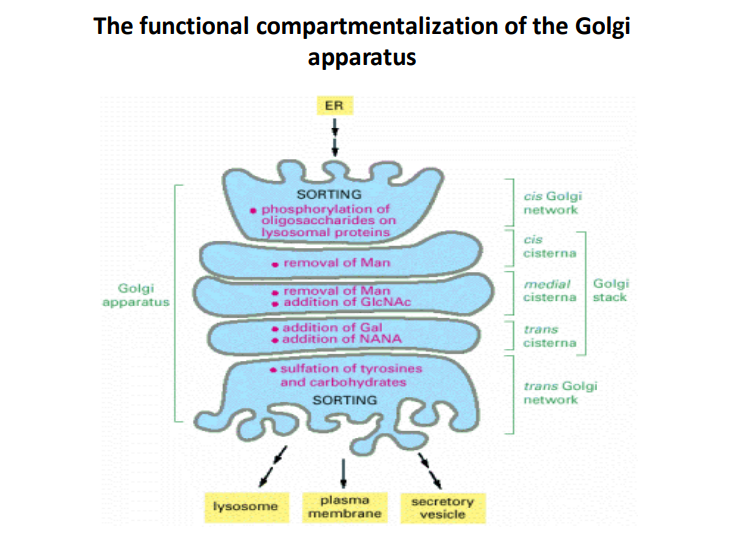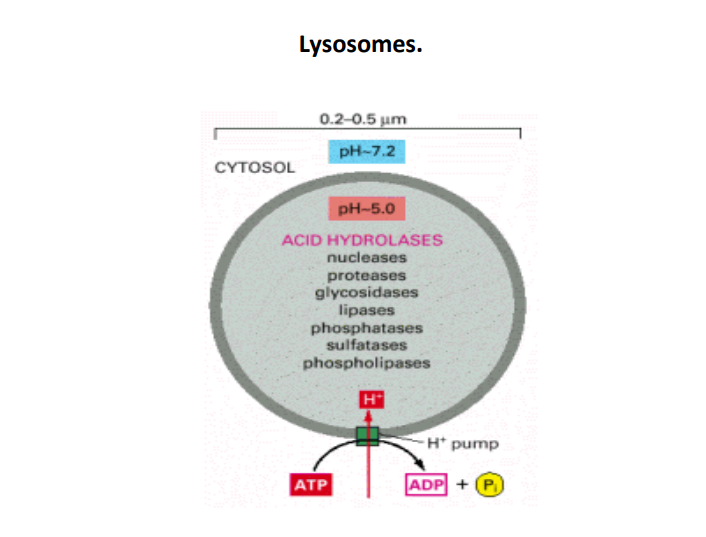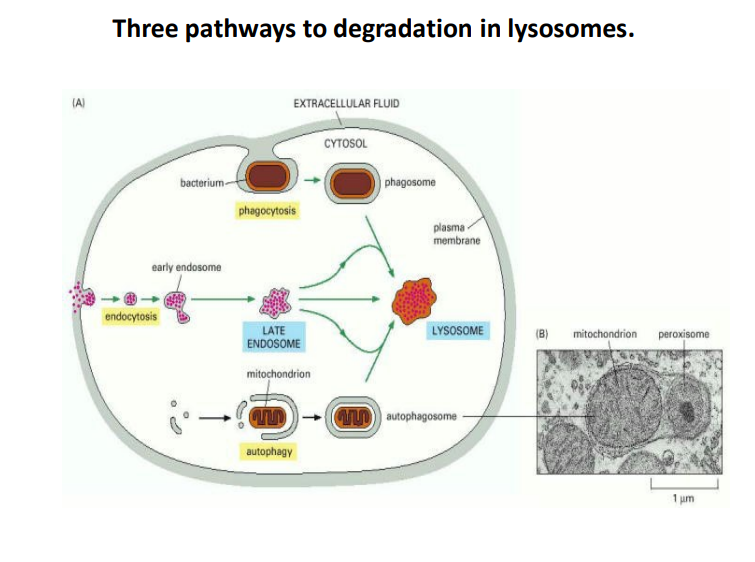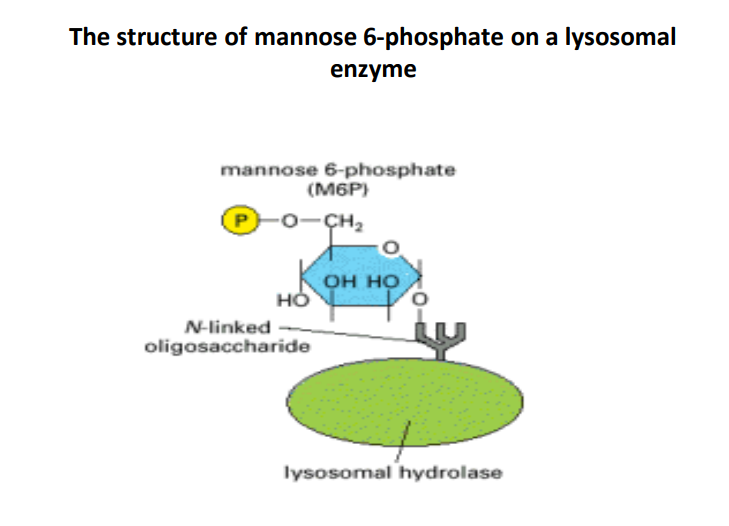The Role and Function of the Golgi Apparatus and Lysosomes
The Functional Compartmentalization of the Golgi Apparatus

Overview of the Golgi Apparatus
- The Golgi apparatus is a vital organelle involved in modifying, sorting, and packaging proteins and lipids for secretion or delivery to other organelles.
- It functions as a processing station between the endoplasmic reticulum (ER) and various destinations within the cell.
Functional Compartmentalization
- The image outlines the specific functions that occur in different regions of the Golgi apparatus, confirming its role as a sophisticated sorting and modifying center.
Key Functional Stages:
-
Cis Golgi Network:
- Sorting & Phosphorylation:
- Proteins are tagged with oligosaccharides, particularly for lysosomal targeting. This process is crucial for the proper routing of proteins to their final destinations.
- Sorting & Phosphorylation:
-
Cis Cisternae:
- Modification of Glycoproteins:
- Removal of mannose, addition of GlcNAc (N-acetylglucosamine). These modifications are essential for the stability and functional activity of glycoproteins.
- Modification of Glycoproteins:
-
Medial Cisternae:
- Further Modifications:
- Removal of more mannose and addition of galactose and NANA (N-acetylneuraminic acid). These steps are critical for specific recognition and functionality of the glycoproteins and glycolipids.
- Further Modifications:
-
Trans Cisternae:
- Sulfation:
- Sulfation of tyrosines and carbohydrates may play a role in cell signaling and receptor interactions, impacting various cellular processes.
- Sulfation:
-
Trans Golgi Network:
- Final Sorting:
- At this stage, proteins and lipids are sorted and packaged into vesicles targeted for either secretion, incorporation into the plasma membrane, or delivery to lysosomes.
- Final Sorting:
Summary of Transport Destinations
| Destination | Description |
|---|---|
| Lysosome | Organelle involved in degradation and recycling of biomolecules. |
| Plasma Membrane | The barrier surrounding the cell, responsible for cell integrity and communication. |
| Secretary Vesicle | Vesicles that carry proteins to be secreted outside the cell. |
Conclusion
- The Golgi apparatus plays a crucial role in post-translational modification and sorting of proteins and lipids, highlighting the complexity and efficiency of cellular processes to maintain homeostasis and proper cellular function. Understanding its structure and function is key in molecular biology and medicine.
Lysosomes

-
Definition and Size:
- Lysosomes are membrane-bound organelles ranging from 0.2 to 0.5 micrometers in size. They function as the cell's waste disposal system, breaking down unwanted materials.
- Their small size allows for efficient transport within the cell and helps in maintaining cellular compartmentalization.
-
pH Levels:
- The pH within lysosomes is about 5.0, which is acidic compared to the cytosol's pH of 7.2.
- This acidic environment is crucial for the activation of the lysosomal enzymes, known as acid hydrolases, which only function optimally at lower pH levels.
-
Enzymatic Functions (Acid Hydrolases) :
- Lysosomes contain various enzymes that facilitate the degradation of macromolecules:
- Nucleases: Break down nucleic acids.
- Proteases: Digest proteins.
- Glycosidases: Degrade carbohydrates.
- Lipases: Breakdown lipids.
- Phosphatases: Remove phosphate groups from molecules.
- Sulfatases: Hydrolyze sulfate esters.
- Phospholipases: Decompose phospholipids.
- Understanding these enzymes helps in grasping how cells recycle and dispose of cellular debris, essential for cell health and turnover.
- Lysosomes contain various enzymes that facilitate the degradation of macromolecules:
-
Proton Pump Mechanism:
- The image illustrates a hydrogen (H⁺) pump, which actively transports protons into the lysosome using ATP.
- This process is vital for maintaining the acidic environment required for the optimal function of lysosomal enzymes. ATP is hydrolyzed to ADP and inorganic phosphate during this process.
- This mechanism showcases the energy expenditure necessary for cellular functions, highlighting the importance of ATP in cellular metabolism.
| Component | Function |
|---|---|
| Acid Hydrolases | Facilitate breakdown of macromolecules |
| - Nucleases | Nucleic acid degradation |
| - Proteases | Protein digestion |
| - Glycosidases | Carbohydrate breakdown |
| - Lipases | Lipid digestion |
| - Phosphatases | Hydrolyzing phosphate groups |
| - Sulfatases | Hydrolyzing sulfate esters |
| - Phospholipases | Breakdown of phospholipids |
| Proton Pump | Maintains low pH for enzyme activation |
In summary, lysosomes are integral to cellular maintenance, recycling macromolecules while ensuring cellular compartmentalization through their unique enzymatic and pH characteristics. Understanding how they operate provides insight into cellular homeostasis and the mechanisms of catabolism.
Extended readings:
Notes on Lysosomal Degradation Pathways

-
Overview of Degradation Pathways:
- The image illustrates three primary pathways leading to degradation in lysosomes: phagocytosis, endocytosis, and autophagy. Each pathway plays a crucial role in cellular homeostasis by degrading various materials.
-
Phagocytosis:
- This process involves the ingestion of large particles, such as bacteria, through the formation of a phagosome. The phagosome then fuses with lysosomes to break down the ingested materials.
- Thoughts: Phagocytosis is vital for immune defense, as it helps eliminate pathogens. It is primarily conducted by specialized cells such as macrophages and neutrophils.
-
Endocytosis:
- Endocytosis is the cellular mechanism of engulfing extracellular fluid and its contents. The early endosome forms after the plasma membrane invaginates and pinches off to trap materials from the extracellular fluid, which can further progress to late endosomes and eventually fuse with lysosomes for degradation.
- Additional Information: This process allows cells to take in nutrients and other molecules, playing a significant role in nutrient uptake and signal transduction.
-
Autophagy:
- Autophagy refers to the process where cells degrade and recycle their own organelles and damaged components through the formation of autophagosomes that subsequently fuse with lysosomes.
- Thoughts: Autophagy is essential for cellular maintenance, especially during stress conditions like starvation or cellular damage, enabling the recycling of cellular components for energy and building blocks.
-
Lysosome Function:
- Lysosomes contain various hydrolytic enzymes that operate optimally at acidic pH levels, allowing them to degrade macromolecules into their constituent monomers, which can then be reused by the cell.
- Summary: Understanding these pathways highlights the importance of lysosomes not only in degradation but also in maintaining cellular health by recycling materials.
-
Supporting Structures:
- The image also notes the presence of mitochondria and peroxisomes, suggesting their roles in energy metabolism and oxidative stress management within the cell.
- Additional Context: Mitochondria are critical for ATP generation, while peroxisomes are involved in lipid metabolism and detoxification processes.
Table of Pathways to Lysosomal Degradation
| Pathway | Description | Key Functions |
|---|---|---|
| Phagocytosis | Ingestion of large particles like bacteria. | Immune defense against pathogens. |
| Endocytosis | Engulfment of extracellular fluid and particles. | Nutrient uptake and cellular signaling. |
| Autophagy | Recycling of damaged organelles and proteins. | Cellular maintenance and energy recycling. |
These notes encapsulate the processes illustrated in the image, emphasizing the significance of lysosomal degradation pathways in cellular functions.
Extended readings:
Mannose 6-Phosphate on a Lysosomal Enzyme

-
Mannose 6-Phosphate (M6P)
- M6P is a crucial marker for lysosomal enzymes that facilitates their transport from the Golgi apparatus to the lysosomes.
- The addition of phosphate to mannose residues allows recognition by specific receptors in the lysosomal membrane.
-
Structure Features
- The diagram shows a sugars structure, where a phosphate group (P) is attached to mannose.
- The hexagonal shape indicates it is a sugar molecule, with hydroxyl groups (OH) contributing to its solubility and reactivity.
-
N-linked Oligosaccharides
- The presence of N-linked oligosaccharides refers to carbohydrate chains attached to the nitrogen of asparagine residues in the protein.
- These oligosaccharides are important for protein stability and function, aiding in proper folding and sorting within the cell.
-
Lysosomal Hydrolase
- Lysosomal hydrolases are enzymes that break down biomolecules in the lysosome.
- The image emphasizes that M6P tags these enzymes, ensuring they reach the lysosome where digestions occur, maintaining cellular homeostasis.
-
Implications in Cellular Health
- Proper functioning of M6P tagging is essential for preventing lysosomal storage disorders, where substrates accumulate due to defective hydrolases.
- Understanding the structure and function of M6P can aid in developing therapeutic strategies for related genetic diseases.
Extended readings: